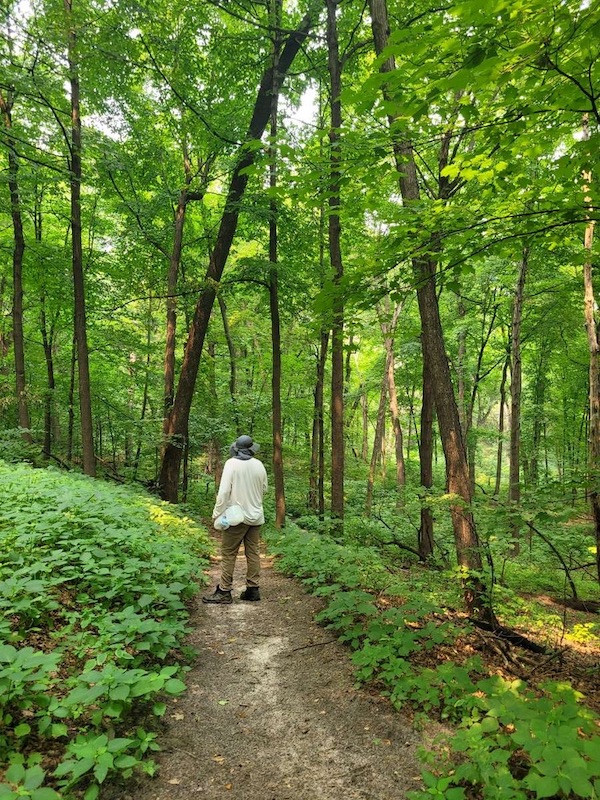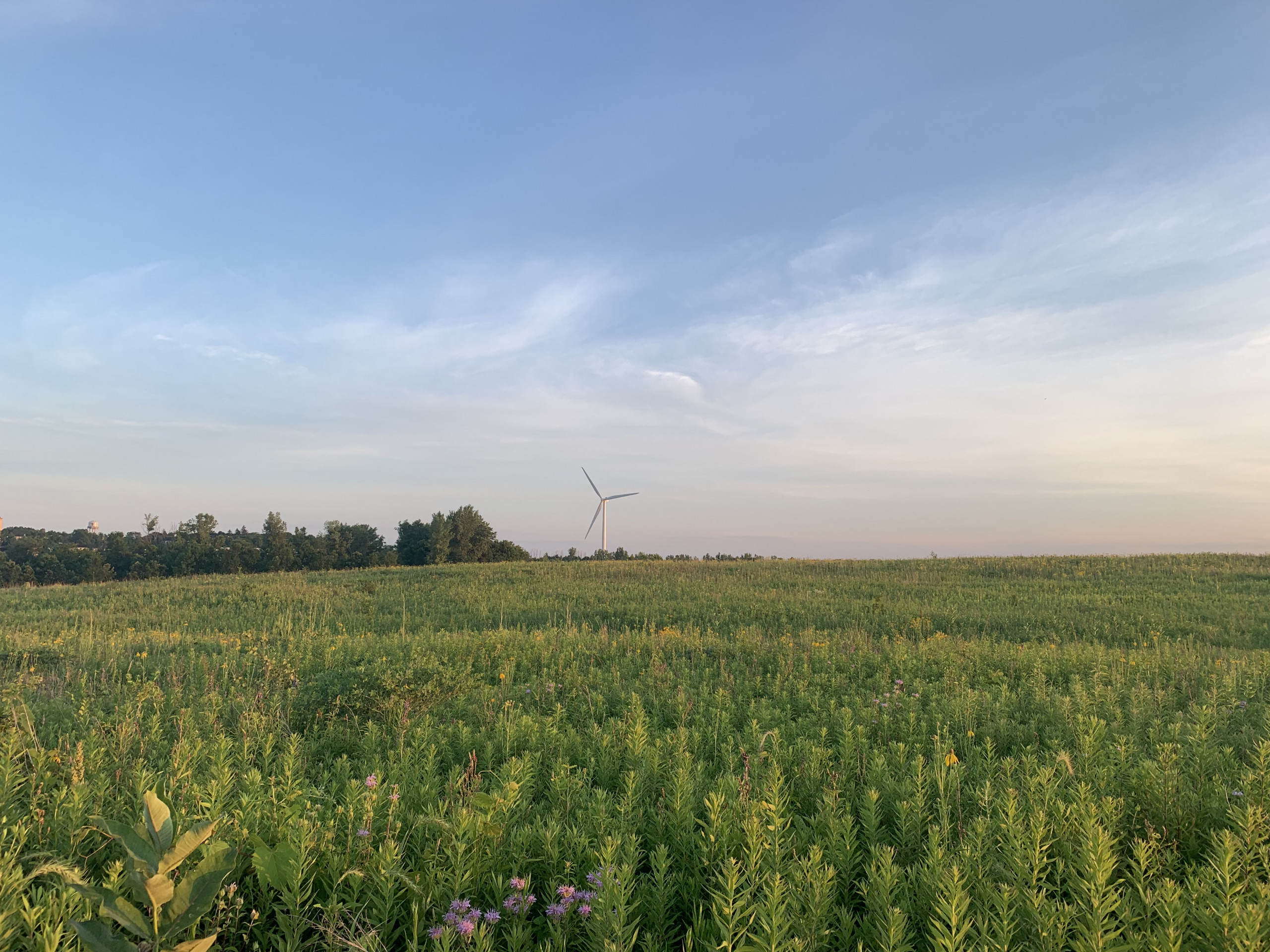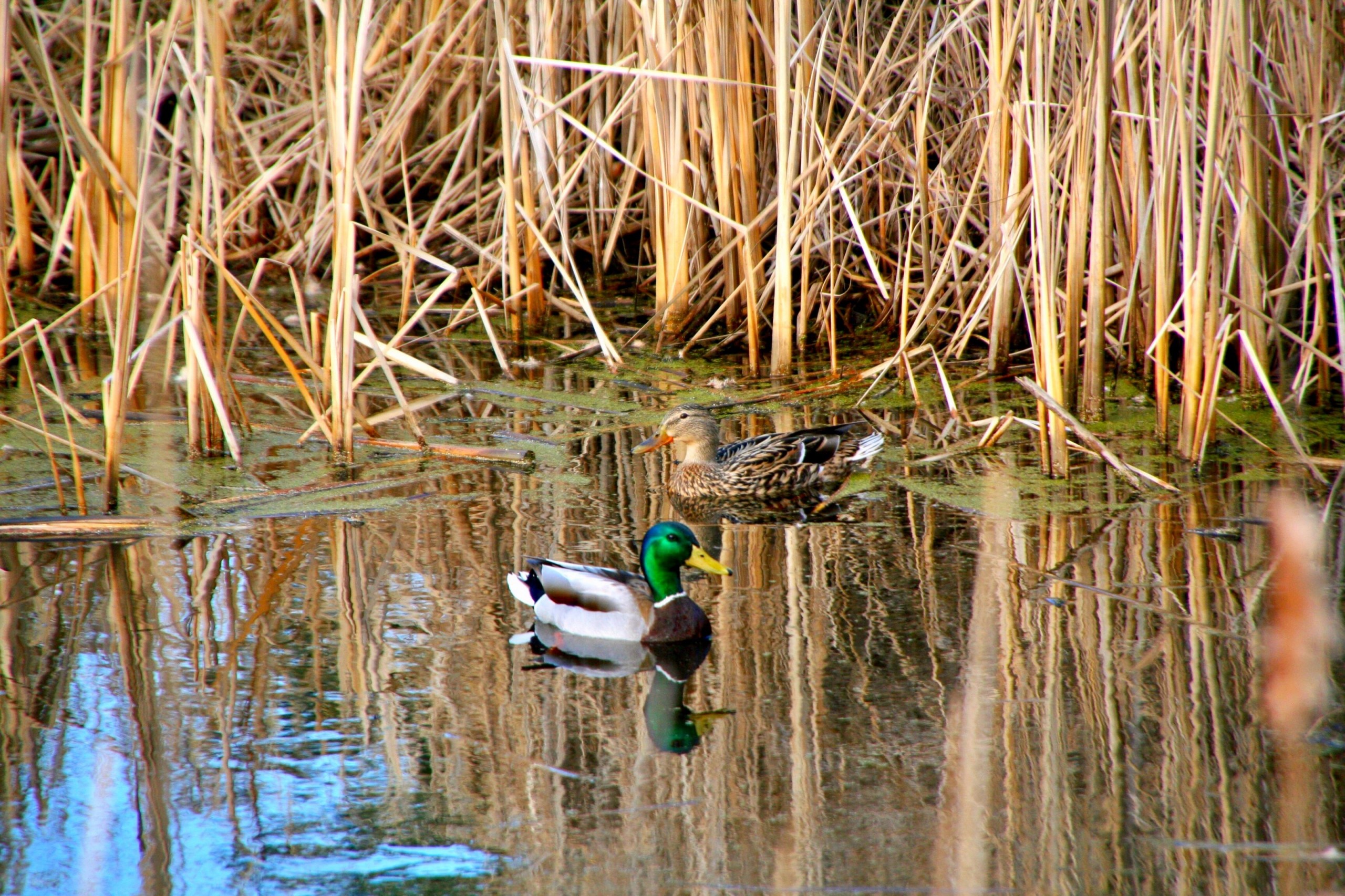Check Out the Different Ecosystems of the Natural Lands

Norway Valley in the summer with Andy Harrison (’23) Photo: Chantel Henderson (’23)
Minnesota’s forest communities are represented by two major ecological habitats; deciduous forests characterize southeastern Minnesota, extending up toward northwestern Minnesota and filled with maple, basswood, and oak, while northeastern Minnesota is characterized as coniferous forest, dominated primarily by pines, white spruce, balsam fir, and stands of aspen and birch.
Much of the deciduous forest biome has been cleared for agriculture since European settlement in the early 1800s. Today, maple-basswood forests occupy less than ten percent of its former area in fragmented patches.1 Conifer forests have also been aggressively logged following the colonization of Minnesota.
Among campus and Natural Lands forests there are many individual trees that are notable. You can learn more about special trees on this story map created by Kelby Anderson ’24.
St. Olaf Forests
Norway Valley, a 15-acre (6 ha) parcel of native hardwood trees is the oldest forest area on campus, representing the Big Woods (maple-basswood) habitat. Wildflowers, or spring ephemerals, cover the floor of Norway Valley in early spring before the trees and shrubs have shaded out the sunlight.
Despite Norway Valley being the oldest restored forest of the Natural Lands, it is not a mirror image of a remnant Big Woods forest. When St. Olaf purchased the land in the 19th century, the previous owner had cut most of the mature trees for logging. The mature trees that can be seen today are either seedlings and saplings too small to harvest or offspring from the original trees. In addition, multiple Norway pines were planted in the valley, likely for aesthetic purposes, which has resulted in a unique blend of native and nonnative trees. Portions of Norway Valley have been cut down as campus has expanded, most recently for Regents Hall of Natural Science. Most of the lumber from this cutting was repurposed for the construction and furnishing of Regents.
Beyond Norway Valley, another forested area in the Natural Lands includes Heath Creek, which consists of a portion of Heath Creek itself, which eventually empties into the Cannon River, along with approximately 75 acres of surrounding forest.
Habitat Maintenance
In order to restore a portion of the Big Woods habitat, St. Olaf has planted over 40,000 tree seedlings to date. St. Olaf’s restored forest encompasses over 100 acres (40ha) of land. This includes seven acres (2.83 ha) of coniferous species, planted primarily for educational purposes.
There are a variety of both native and invasive species in forests that require management. Common buckthorn (Rhamnus cathartica), an invasive midstory tree species that can crowd out native plants and harm animals that ingest its berries, is commonly removed by cutting the trunk close to the ground, followed by applying herbicide to the cambium. A similar strategy is used for Oriental bittersweet (Celastrus orbiculatus), an invasive vine that can strangle trees and break branches from excess weight.
During the winter months, much of the management efforts in Heath Creek and other forests include stump-treating buckthorn, followed by condensing the cut trees into brush piles, where they can be burned or left to serve as carbon-sinks as they are broken down by detritivores and used as habitat for a variety of species.
Spring ephemerals, or plants that have a rapid growth and reproduction phase before dying back to their below-ground biomass, are a common sight in forests as plants begin popping back up following snowmelt and before the canopy closes. The seeds of these native species are often collected and spread to other forested areas.
1 – Shea, Kathleen L. and Sonja R. Helgeson. “Tree Growth Patterns, Mortality, and Colonization in a Restored Maple-Basswood Forest.” Ecological Restoration, vol. 36 no. 4, 2018, p. 295-305. Project MUSE muse.jhu.edu/article/709449.


Prairies are open grasslands that usually occur in relatively dry climates. In natural conditions, they have very high levels of plant, insect, and bird diversity. Originally, half of Minnesota was covered by prairie, but due to rich prairie soil being desirable agricultural land, the abundance of prairies have been drastically reduced following colonization. Once covering an estimated 7,300,000 hectares across Minnesota, prairie has since been reduced by 99.6%, with much of the remaining land being highly fragmented.1
St. Olaf Prairies
St. Olaf College has restored over 150 acres of native prairie on College-owned land that has been farmed in corn and soybeans for decades. The restored prairies have over 10 species of native grasses and over 60 species of native forbs (wildflowers). We collect seed from both on and off-campus locations, ensuring both species and genetic diversity are present within the prairies.
Habitat Maintenance
Invasive species control is necessary in prairies, especially newly established ones. We use various methods to control invasive species including digging, cutting, spot spraying, and burning.
We manage our prairies prescribed burns approximately every 4-6 years. This helps to control noxious weeds and also stimulates the fire-adapted native prairie plants. Fire breaks are established by mowing. Basic equipment needed includes drip torches to start fires, along with backpack water sprayers and flappers (heavy rubber mat on a long handle) used to control and put out fires. You can visualize the history of prescribed fire in the St. Olaf Natural Lands here.
- Fred Samson, Fritz Knopf, Prairie conservation in North America, BioScience, Volume 44, Issue 6, June 1994, Pages 418–421, https://doi.org/10.2307/1312365

Spring 2019 Photo Contest in the Animal Category: “Duck Duck Grey Duck” by Alex Oberg
Minnesota was full of wetlands prior to colonization. However, farmers installed drain tiles and ditches to drain fields for farming. Thus, Minnesota has a lot of great farmland and a lot less wetland. In the major farm regions of Minnesota, we’ve lost about 95% of our shallow wetlands. As the understanding of the ecological and economic value of wetlands has grown, so have their conservation and restoration efforts.
St. Olaf Wetlands
Fifteen wetlands have been restored on campus since 1992. They range in size from small ephemeral (temporary) ponds up to 9 acres of surface water (Big Pond). They were constructed through the U.S. Fish and Wildlife Service Wetland Restoration program. These wetland sites, drained years ago for agriculture, were identified by surveying and from topographic maps. Dikes were constructed and field drain tiles were removed if present. All wetlands are surrounded by other natural areas (prairie and woodlands) to buffer them from agriculture and development runoff. The wetlands are part of the Cannon River watershed and help with seasonal flood control, soil stability, and groundwater recharge as well as provide valuable wildlife habitat.
These wetlands now have many nesting waterfowl as well as populations of herptiles including a variety of frogs and painted turtles (Chrysemys picta). Some of the most common birds you’ll see on the wetlands include mallards, wood ducks, blue-winged teals, and Canada geese. We have also welcomed nesting green herons, hooded mergansers, whooping cranes, and pied-billed grebes. Wetlands are vital for migrating bird species, providing stopping points as they move north and south in search of food and favorable climates. Our wetlands provide migratory rest stops for more than 30 species of waterfowl, ranging from ruddy ducks to tundra swans. We have observed up to 500 waterfowl of many species resting on Big Pond at one time during fall and spring migrations. Despite our wetlands being a valuable habitat for waterfowl and herptiles, they are absent of fish. Their shallowness makes them uninhabitable in the winter due to low oxygen levels once they ice over.
Habitat Maintenance
Our primary concern when it comes to managing wetlands is invasive species such as reed canary grass (Phalaris arundinacea) and hybrid-invasive cattails (Typha x glauca). European narrowleaf cattail crossbred with native broadleaf cattail as its population spread west through North America, and the resulting hybrid, unlike its native parent, forms thick monocultures that crowd out native plants and degrade habitat quality for wetland creatures. To help control the populations of these cattails, we can perform prescribed burns or treat them with water-safe herbicides. A common native species in our wetlands is arrowheads (the Sagittaria genus), which fittingly have large, arrow-shaped leaves.
Drought, contrary to popular belief, can be beneficial to wetlands in a similar manner that fire is beneficial to prairies. Dry periods can stimulate new emergent plant growth as they allow plants to germinate in wet soil rather than trying to germinate underwater. These drought cycles can also stimulate new invertebrate life cycles that are a very beneficial part of the food chain to waterfowl, amphibians, and other forms of aquatic life.
You must be logged in to post a comment.